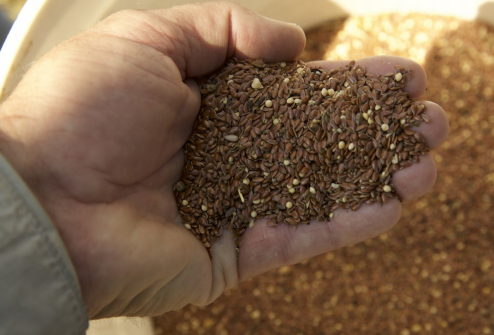When he started farming in 1987, Curtis Sayles went through a new pair of work boots every year. These days, he’s still wearing a pair he bought three years ago.
The difference? Sayles stopped using harsh fertilizers on his fields that ate through the leather of his boots. Sayles, a fourth-generation farmer with 6,000 acres near Seibert in eastern Colorado, now practices regenerative agriculture, a multi-faceted style of farming that advocates say has a host of benefits, including improved water efficiency, water quality and profitability. Above all, regenerative agriculture can help restore healthy, fertile soils.
Farmers like Sayles — and those who want to get started with regenerative agriculture — are getting a boost through a renewed partnership between the U.S. Department of Agriculture’s (USDA) Natural Resources Conservation Service (NRCS) and the Colorado Department of Agriculture’s Colorado State Conservation Board.
In October, the agencies entered a five-year, $5 million agreement to support regenerative agriculture, soil health, water conservation and urban farms. This agreement provides funding for 25 existing conservation positions across Colorado. It also helps fund five new positions to support the state’s focus on soil health and one to support urban farmers.
The Colorado Department of Agriculture launched its Soil Health Initiative in 2020, with the goal of helping farmers and ranchers boost their land’s productivity and drought resiliency by improving soil health. Other soil health initiatives are also underway, led by groups like the Colorado Collaborative for Healthy Soils and Farmers Advancing Regenerative Management Systems (FARMS).
Regenerative agriculture, which prioritizes soil health, has garnered interest over the last 10 or so years as farmers and ranchers grapple with challenges like variable crop prices, climate change and increasing expenses, says Clint Evans, Colorado state conservationist for the NRCS.
“A lot of producers have started looking at soil health as a way that, over the long term, can help improve their overall sustainability and resources on their farm or ranch and help them become more profitable,” Evans says.
Common tenets of improving soil health are minimizing soil disturbance while maximizing soil cover, biodiversity, and the presence of living roots. In practice, this means farmers stop or reduce tilling the land, plant cover crops, grow a strategic rotation of diverse crops, add mulch, and introduce grazing livestock.
Over several years, these practices can lead to rich soil that naturally retains moisture, produces nutrient-rich crops, and staves off weeds and pests. According to the USDA, healthy soil practices can help reduce evaporation rates, while healthy soil itself can hold more water, two outcomes that are especially helpful during drought. What’s more, reducing the use of fertilizers, pesticides and herbicides helps protect groundwater from chemical leaching. Healthy soil practices also reduce runoff and erosion, which keeps sediment out of lakes, rivers and streams.
“Soil health could be the baseline to healthy forests, healthy rangelands, healthy croplands,” Evans says. “All across agricultural lands, it could really be the foundation for drought resiliency and higher productivity even as climate and rainfall cycles change.”
Sarah Kuta is a freelance writer based in Longmont, Colorado.
An extended version of this story originally appeared in Fresh Water News, an initiative of Water Education Colorado.


 Print
Print